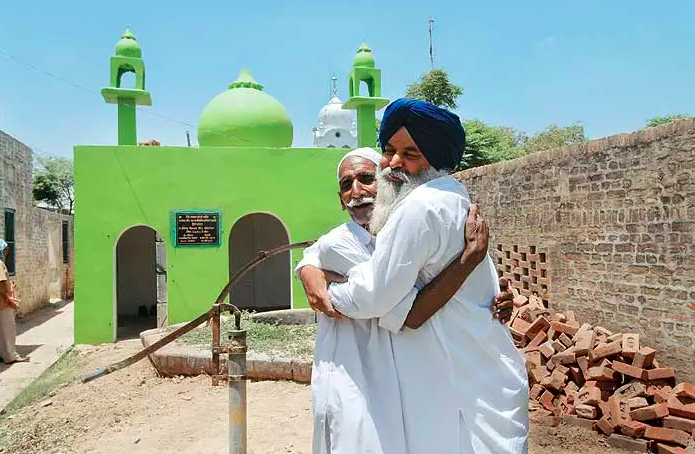
1) This summer, the film Sound of Freedom found both a worldwide audience and a place in the culture wars because of its religious and political associations. At the box office, the movie actually beat the supposed summer blockbusters, the final farewell to the “Indiana Jones” character and another installment of the “Mission Impossible” series, earning about $190 million in the domestic market. But it quickly found a special place among evangelical Christians and conservative Catholics. Sound of Freedom is a classic action-thriller about a disillusioned American special agent who quits his job at the Department of Homeland Security and masterminds a rogue operation to smash an international child sex-trafficking ring. But it became an “outsider” kind of movie because its main character is a devout Roman Catholic (even though there is only one scene where this becomes obvious, when he gives his St. Timothy medallion to one of the at-risk kids) and because of the faith-based focus of its distribution company, Angel Studios.

The fact that the film’s star, Jim Caviezel, who famously played Jesus Christ in Mel Gibson’s The Passion of the Christ, had been making some sympathetic statements in press events on QAnon themes that went beyond the very real issue of child sex-trafficking (statements involving Hillary Clinton, for instance) was enough to have the movie labeled as “That QAnon Movie” by Hollywood critics. One of the film’s screenwriters, Rod Barr, argues that the character and plot of the movie are from real life and that if Caviezel and Angel Studios were replaced by a more mainstream actor and distribution company the film would not be controversial at all. The Catholic element is not unusual in films in the recent past. While Barr had denied that Sound of Freedom is a “faith-based” movie (a term used in Hollywood to mean Christian), he has since embraced the label, saying, “Let’s make faith part of our cultural discussion.” (Source: Commentary, September)

Secular Sabbath gathering (source: Secular Sabbath).
2) Without a large membership, Secular Sabbath, a new-style spiritual “club,” has received considerable publicity, probably due to the significant number of celebrities it has drawn (as well as their children). The members-only club hosts bimonthly events, usually in Los Angeles but also in far-flung places like Iceland, Mexico and, at the end of the year, Antarctica. The community’s 32-year-old founder, Genevieve Medow-Jenkins, says that the group is a continuation of Esalen, the holistic spiritual retreat in California where she spent her youth. She became disenchanted by the commercialization and high costs of Esalen and since 2016 has been leading spiritual retreats and “pop-up” spiritual experiences at spas, private homes, and the popular desert town of Joshua Tree, Calif. For a $180 annual membership, club members can engage in breathwork, cacao ceremonies, and “soundbaths.” Medow-Jenkins sees the club as an alternative to established religions, hoping to draw the growing number of religiously non-affiliated to such an informal center of spiritual practices and teachings. The club is distinctive for its lack of rules, not even holding its events on the traditional Jewish Sabbath (Medow-Jenkins has a background in Judaism but disaffiliated because of what she viewed as its judgmental attitudes). Members speak of the “cafeteria approach” of Secular Sabbath, where they are free do adopt a spiritual practice that suits them. Medow-Jenkins says the club has a “couple hundred of its members,” but has received a good deal of publicity on such social media sites as Instagram. (Source: The Free Press, September 25)
3) The village of Kutba Bamaniya, among others in the Punjab region of India, has been experiencing a revival of mosque building and rehabilitation in recent years by a unique coalition of Hindus and Sikhs. In a region that is 57.7 percent Sikh, 38.5 percent Hindu, and less than 2 percent Muslim, the villagers of Kutba Bamaniya, led by Sikh leader Buta Singh, have embarked on a mission to not only restore their ancient mosque’s physical structure but also preserve the legacy it represents. The mosque has become a beacon of unity in a region that experienced the destruction of mosques and other religious structures during the partition of India in 1947 and a significant drop in the Muslim population (from over 40 percent at the time of India’s independence to less than 2 percent today). Efforts to restore religious sites damaged nearly seven decades ago have been ongoing in the area. While Muslims in the village had migrated to Pakistan during the partition, a few families stayed behind, making the decision to restore the mosque not only an act of rebuilding but a gesture to reclaim a shared history and reaffirm unity.
“The mosque’s construction was a collaborative endeavor, reflecting the spirit of all communities involved,” Singh says. “We urge the people of Punjab and India to emulate our communal harmony. Regrettably, we haven’t received government support. The creation of both the gurdwara and the mosque was solely through our collective efforts.” Over 165 mosques have been restored in recent years. The local communities residing near damaged religious places have often taken it upon themselves to restore and maintain these sites, bringing together Sikhs, Hindus, Muslims and other religious groups to build and preserve a shared heritage. Interfaith groups have likewise come together to restore and maintain religious places. (Source: Religion Unplugged, September 18)

Source: Paderborner ‘SJ’ Blog.